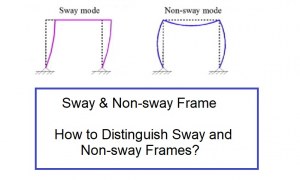🕑 Reading time: 1 minute
Two way slab design by direct design method as per ACI 318-11, step by step procedure and limitations of direct design method for two way slab is presented. Generally, there are two types of slab which are one way and two way slabs. The one-way slab is deflected in one way direction and primary reinforcement is placed in one direction whereas the two-way slab deflect in two directions and primary reinforcement placement is in two directions. ACI 318-11 Code provides two methods for two way slab design one of which is direct design method. Direct design method, that could have been named the direct analysis method because it determines or prescribes moments for different parts of the slab panel without the need to conduct structural analysis, is explained in the following sections.Contents:
Procedures of Two Way Slab Design by Direct Design Method
- Determine slab type and layout
- Choose slab thickness that should be adequate for avoiding excessive deflections and satisfy shear at interior and exterior columns.
- Choose design method (direct design method in this case)
- Calculate positive and negative moments in the slab
- Distribute moments across slab width
- Specify portion of moments to the beams, if beams are present
- Compute reinforcements for moments that found in two previous points
- Check shear strength
Limitations of Direct Design Method
- There must be at least three continuous spans in each direction. If there are fewer panels, the interior negative moments tend to be too small.
- Panels should be rectangular and the ratio of longer/ shorter spans within the panel must not exceed 2 otherwise one way actions will prevail.
- In each direction, successive span lengths must not differ by more than one third of the largest span length.
- Column offset of more than 10% of the span (in the direction of offset) from either axis between centerline of successive column is not permitted.
- This method is applicable for slab that subjected to gravity load only.
- Unfactored service live load should not to be more than two times unfactored dead load.
- f beams were used, beam relative stiffness between two perpendicular directions must be between 0.2-0.5.
Two Way Slab Design by Direct Design Method
Before the start of two way slab design, slab depth should be determined in addition to specify column strips and middle strips. In this article, it is assumed that slab thickness is determine but calculation of column and middle strips is explained in the following section:Column and middle strips
There are continuous variations of moments across slab panel therefore to help placement of steel, design moments are averaged over column strips and middle strips. The column strips are located over columns and have a width on each side of the column centerline equal to smaller panel dimension divided by four and middle strips is located between two column strips. Figure-1 and Figure-2 illustrate middle strip and column strip for long and short directions of panel.
Figure-1: Column and Middle Strip in Short Direction of the Panel

Figure-2: Column and Middle Strips in Long Direction of the Panel
Total static moment for a span (Mo):
Clear span (ln) which is extended from face to face of walls or columns, in the direction of moments is used to compute total static moment in a panel. Factored moment in as span is calculated as per the following equation:
Figure-3: Column and middle strip in both direction of the slab with necessary parameters for calculating total static moment
Distribution of total static moment to positive and negative moments
1. For interior spans:
Total static moments are distributed to positive and negative moments as per the following ratios: Negative factored moment -Mu = 0.65Mo Positive factored moment +Mu = 0.35Mo2. For edge spans:
Total static moment is distributed to negative exterior moment, interior moment, and negative interior moment as per Table-1.Table-1: Factors applied to static moment for positive and negative moments
 End span and interior span slabs are illustrated in Figure-4
End span and interior span slabs are illustrated in Figure-4

Figure-4: Distribution of total static moment to critical sections in interior and end spans
Lateral distribution of moments between column and middle strips
After assigning total static moment into positive and negative moments, it is necessary to distribute these moments to middle and column strips. For design purposes, moments are assumed to be uniformly distributed to column and middle strips except beams are present. Positive and negative moment distribution to column and middle strips is depend number of parameters which will be explained in the following sections: A. The ratio of (l2/l1), B. Relative stiffness (af) of beams and slabs spanning in each direction: is expressed as:
Figure-5: Portion of slabs to be included for moment of inertia calculation, edge beam (left side) & internal beam (right side)

Figure-6: Dimensions of internal and external slab for moment of inertia calculations
C. Degree of tensional stiffness provided by edge beams which is expressed by parameter
Figure-7: Two possible subdivisions of L-section in rectangles for torsion constant C
With these parameters defined positive and negative moments are assigned to column and middle strips. Table-2 used to specify portion of positive and negative moments to column strip and interpolations when it is required. When beam is present along column line in the direction of l1, 85% of column strip moment is resisted by the beam ifTable-2: Column strip moment, percent of total moment at the critical section
 Now, moments are assigned to different parts of slab panel, and it is easy to find reinforcement ratio for those moments.
Now, moments are assigned to different parts of slab panel, and it is easy to find reinforcement ratio for those moments. 

